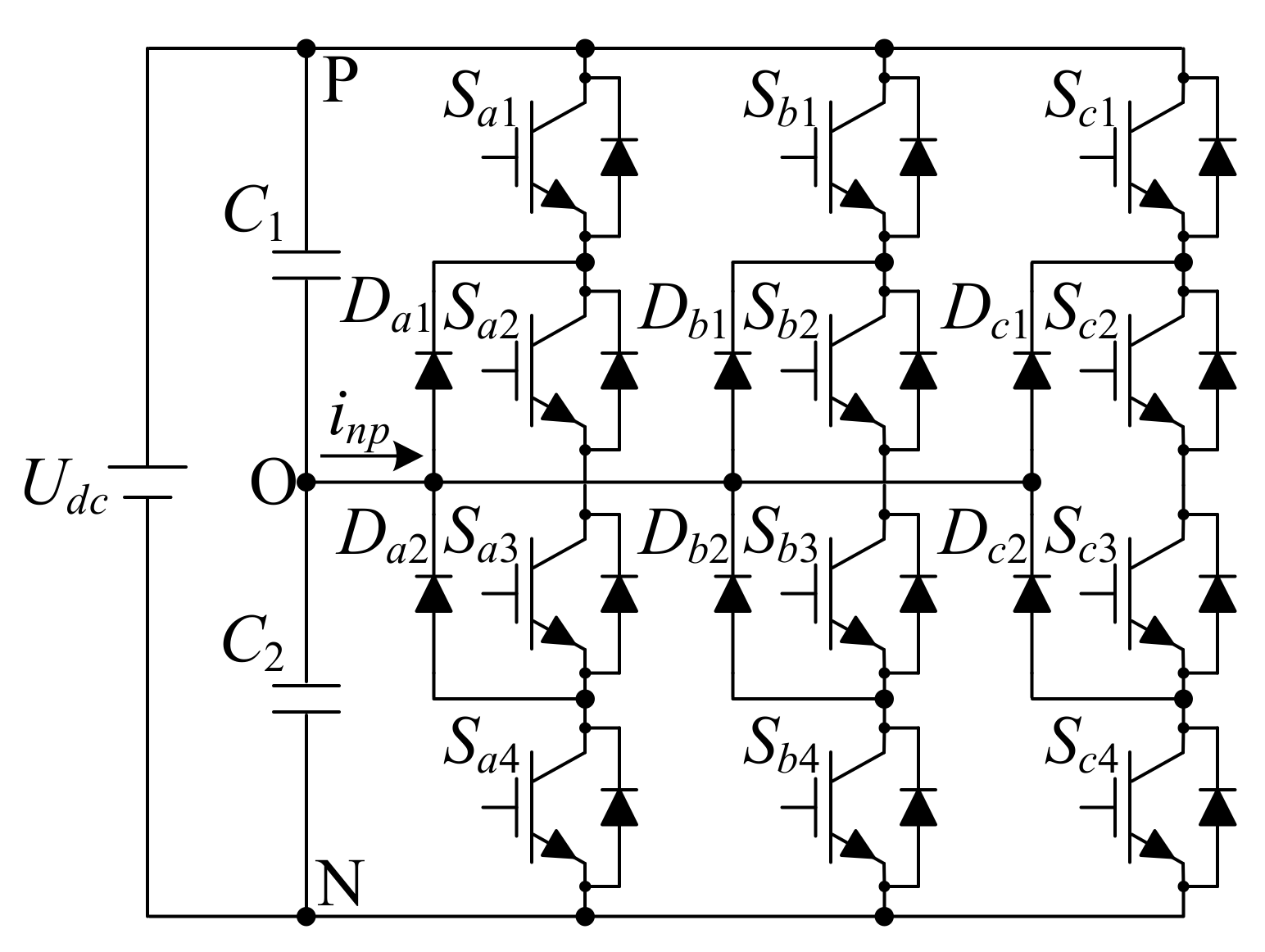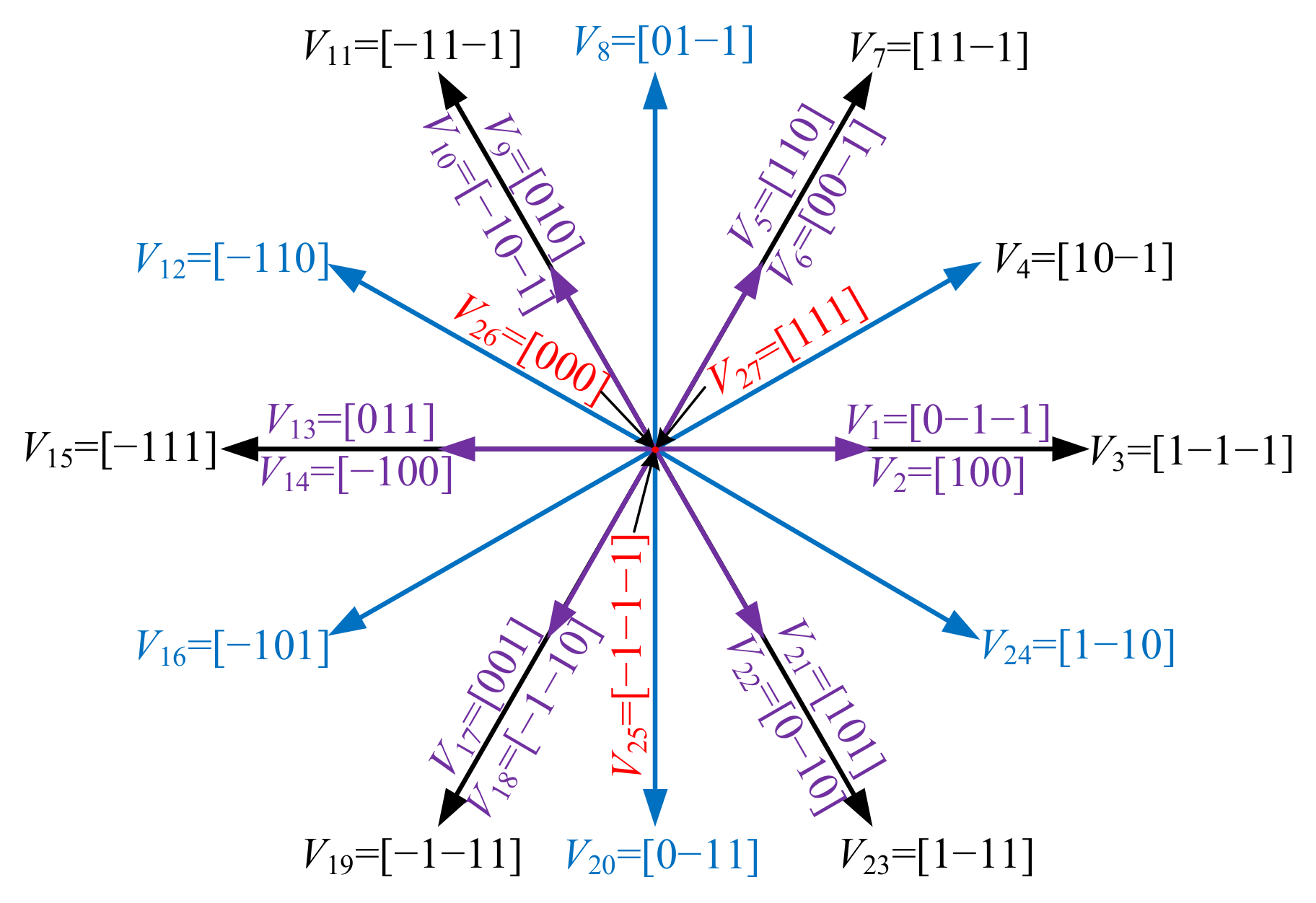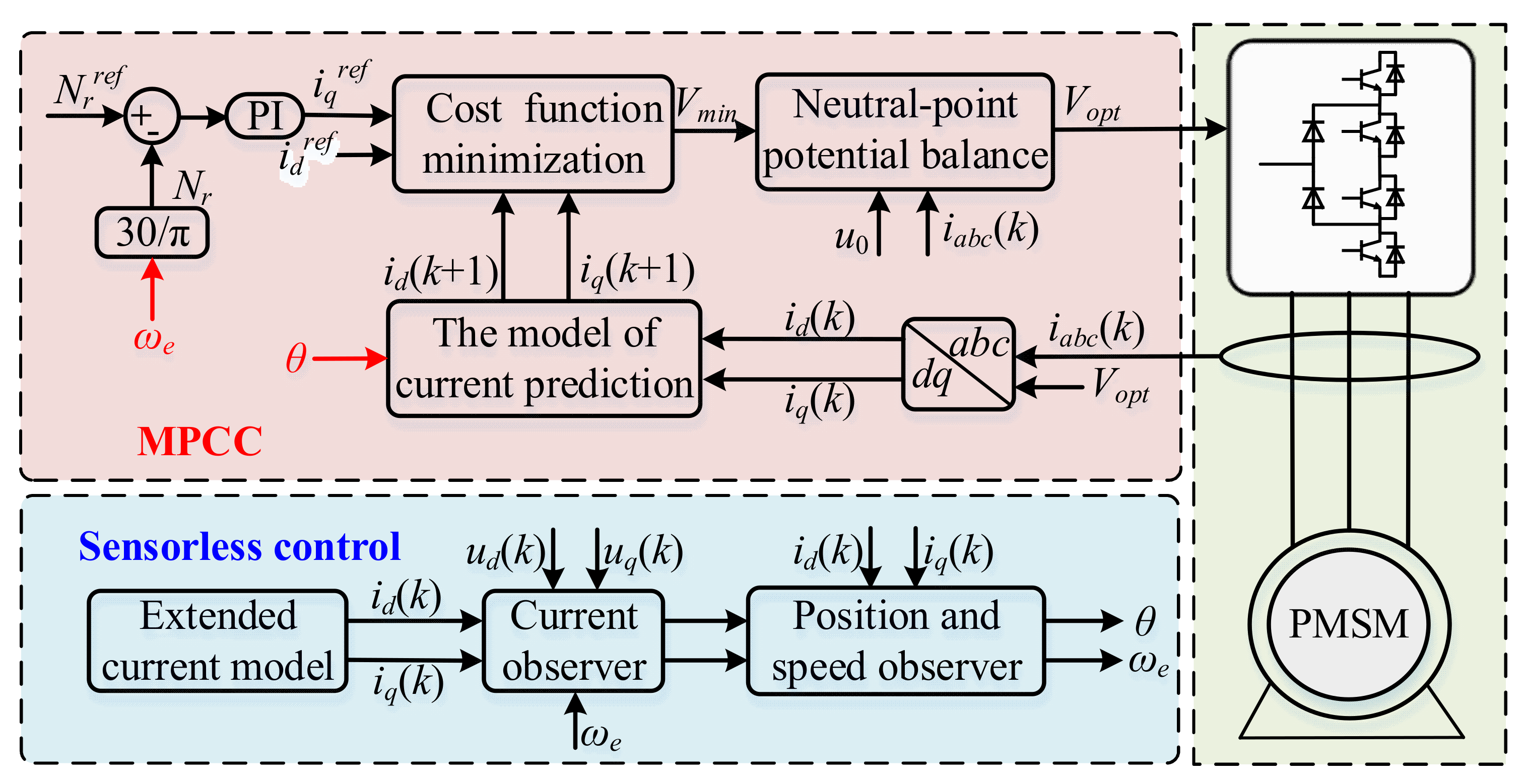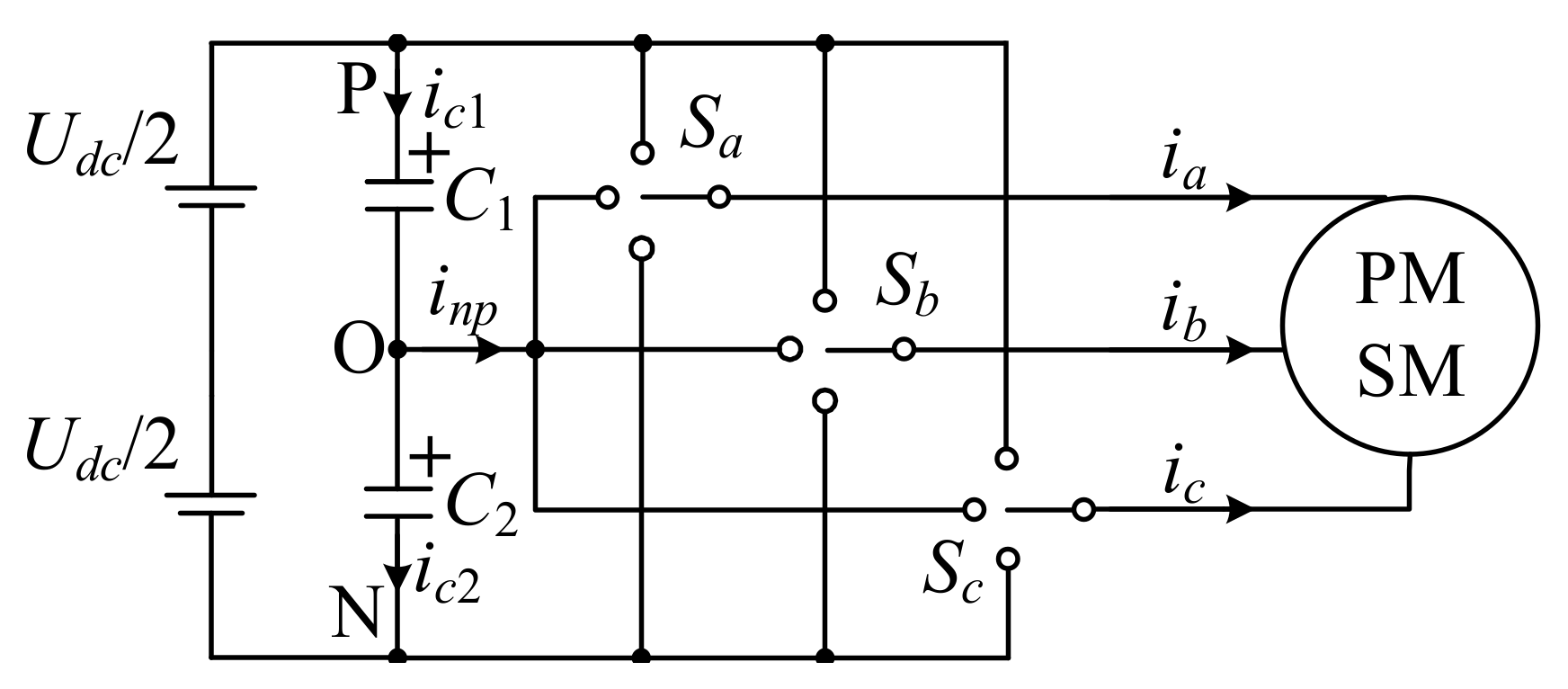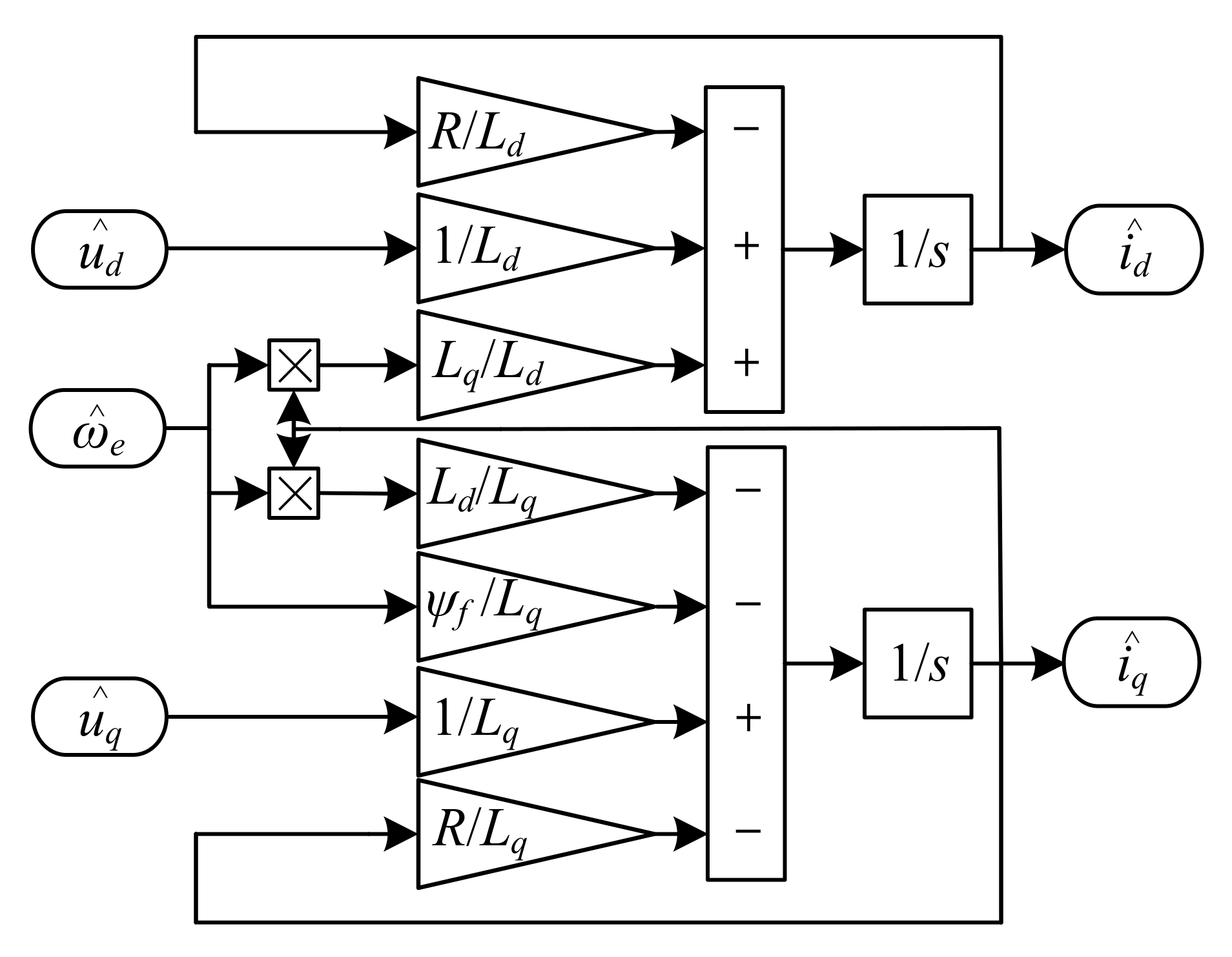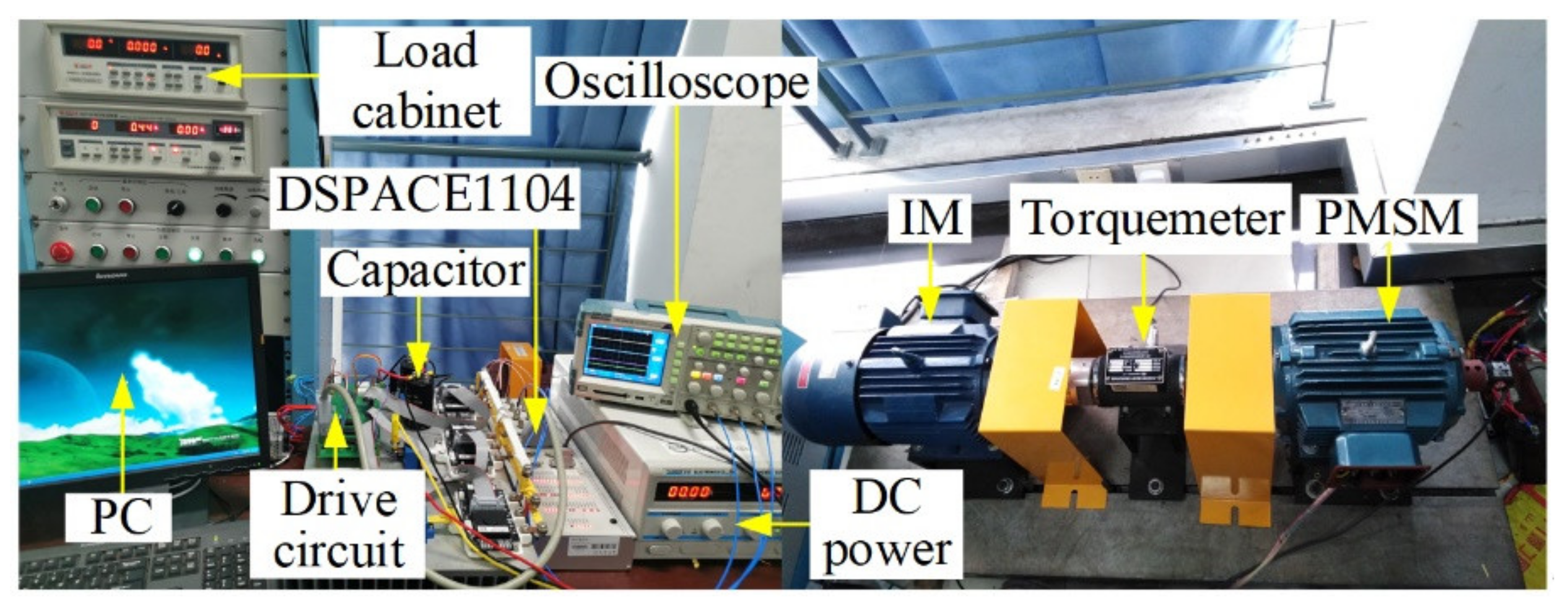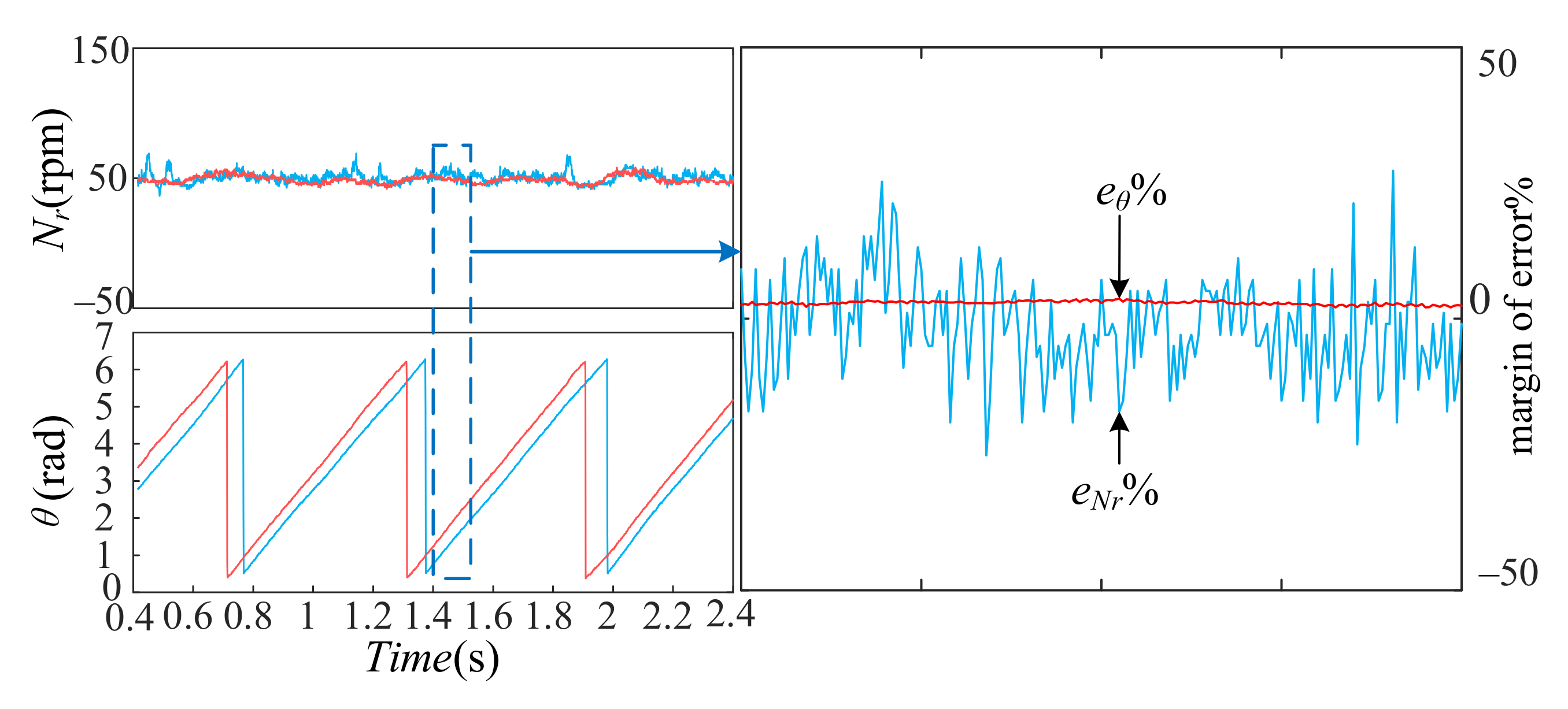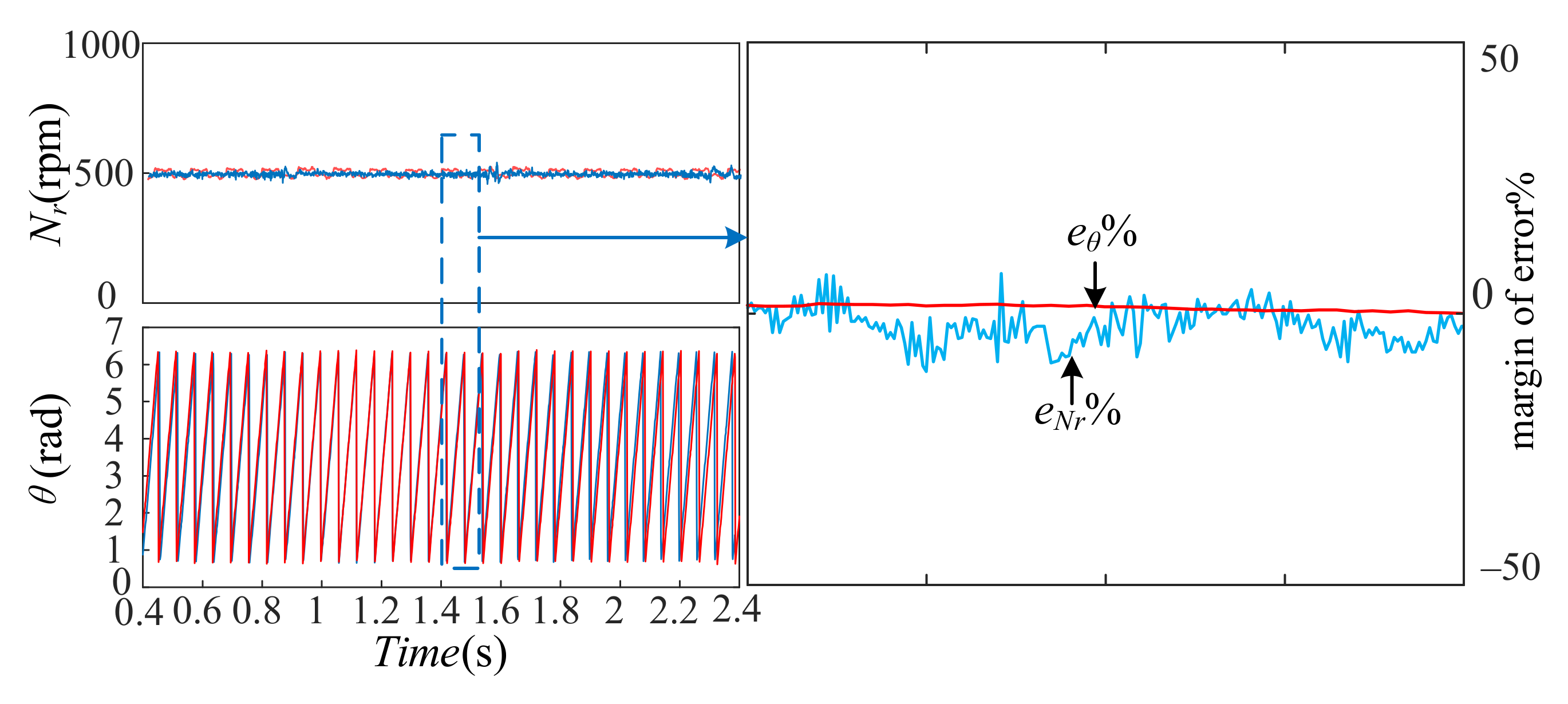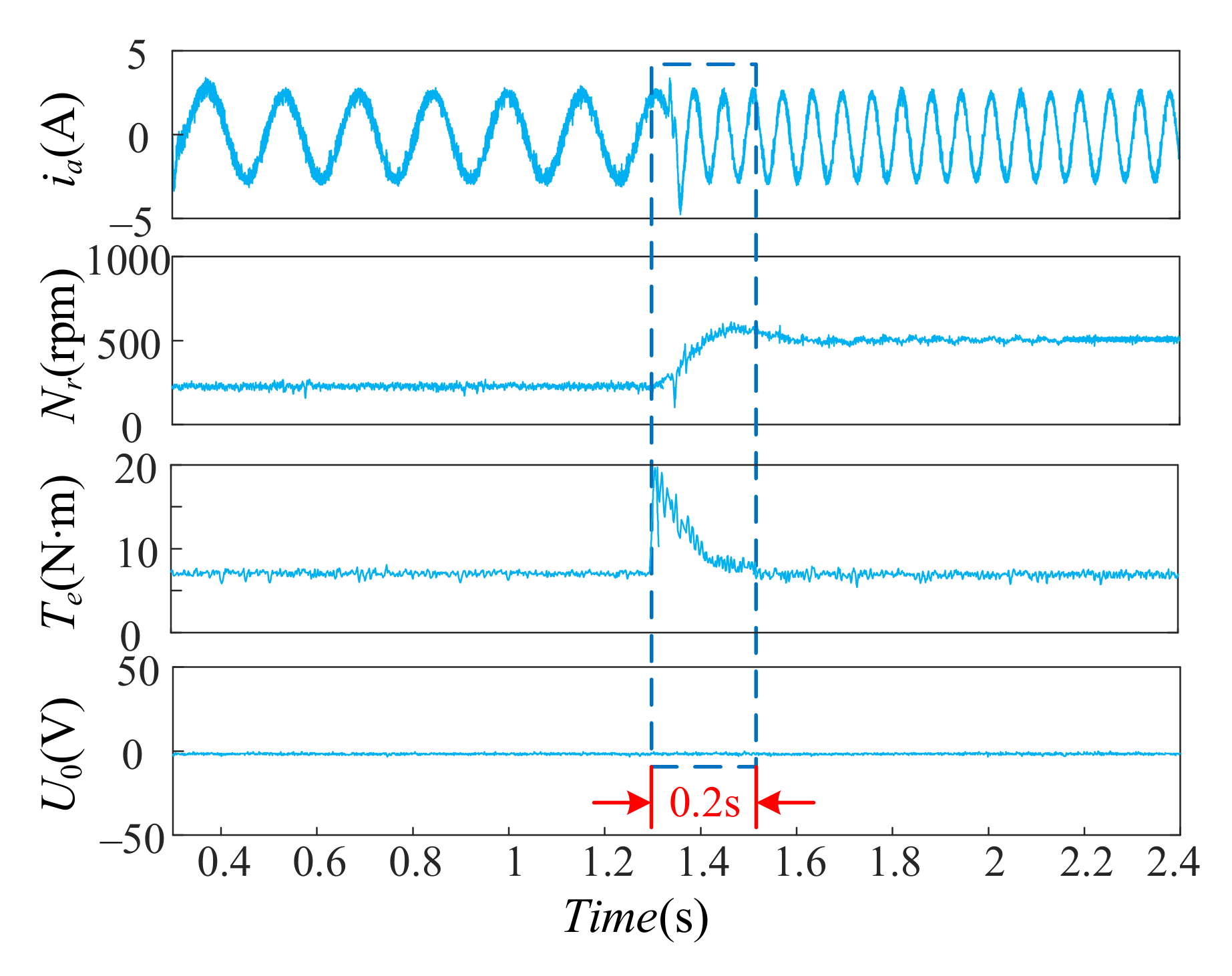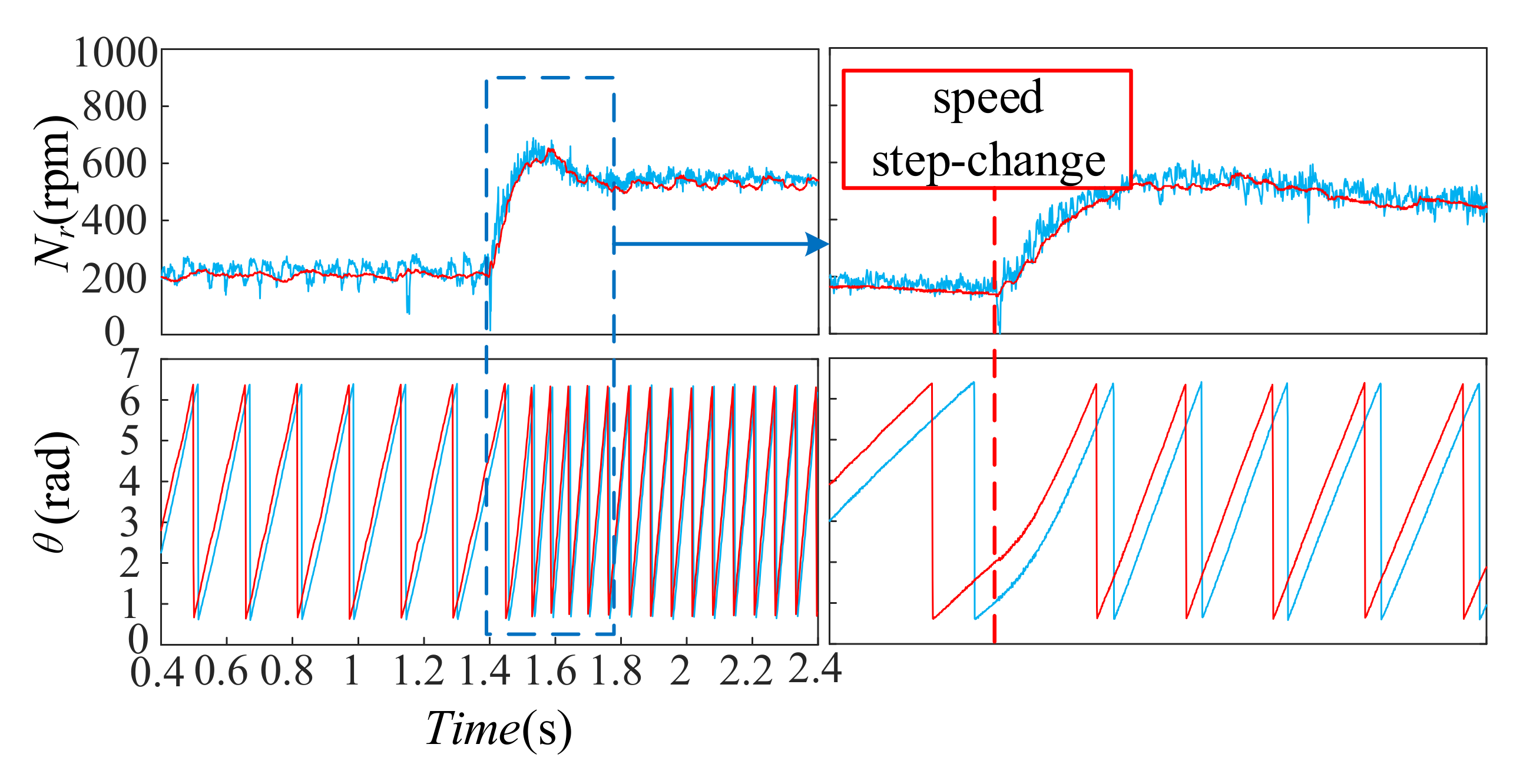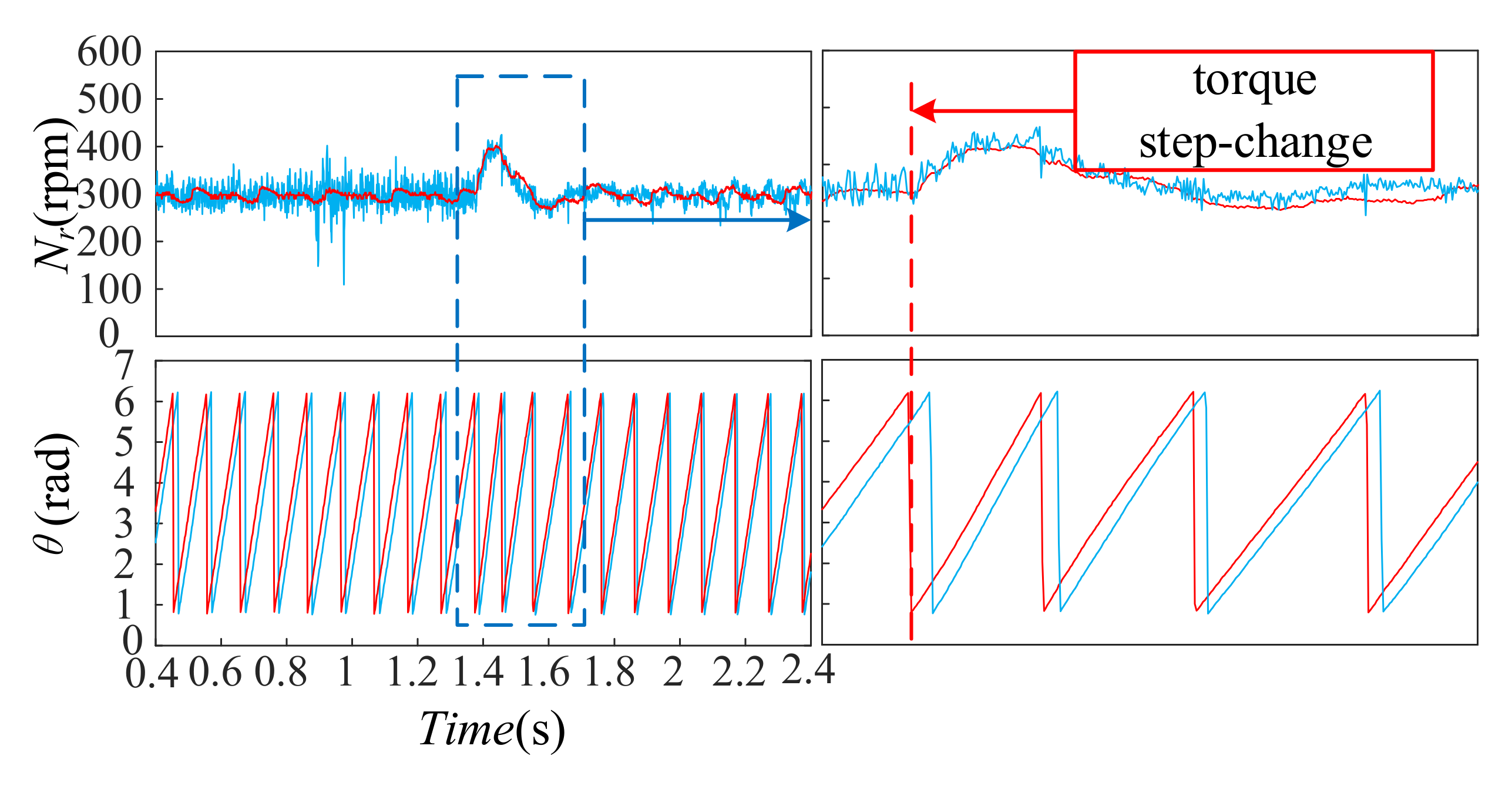1. Introduction
Among various types of motor drives for EVs, a permanent magnet synchronous motor (PMSM) drive is attractive due to its commercial merits, such as its high efficiency and high power density [
1,
2,
3,
4]. In terms of PMSM drive technologies, traditional control techniques mainly consist of vector control (VC) and direct torque control (DTC) [
5,
6]. A PMSM drive relying on VC can perform comparably in dynamic characteristics to a direct current machine drive, while requiring complex coordinate transformation and significantly depending on precise machine parameters. In addition, a DTC drive suffers from the drawback of extensive calculation and greater real-time requirements, although it is simpler in structure. In comparison to the aforementioned techniques, model predictive control (MPC) possesses key features, namely, quick responsiveness, multi-objective evolutionary capability, and a simple principle [
7,
8,
9], with this method having gained significant interest in recent years. On the other hand, the three-level, neutral-point-clamped (3L-NPC) inverter has been applied to motor drives [
10], owing to its superiorities in voltage distortion, semiconductor stress, and switching frequency [
11,
12,
13,
14]. The aforementioned control techniques have been actively extended to a 3L-NPC-powered PMSM drive. When traditional methods are chosen, an additional control loop is required to keep neutral-point voltage (NPV) balance, complicating the overall control system. When aiming to eliminate the additional control loop, MPC is undoubtedly the most feasible option because of its effectiveness in terms of solving such an optimization problem with multi-objectives.
Regardless of the control strategies employed and the inverter’s topologies, installing a position sensor is normally required and is essential for an EV application. As such, once the sensor or the connecting cable breaks down, the machine, and hence the vehicle, will be out of control. For this reason, integrating a sensorless position control as an alternative option is necessary to ensure the safety of the EV when the position sensor is faulty. Conventional sensorless position control methods can be partitioned into two methodologies for different speed ranges: a back-electromotive force (BEMF)-based scheme for mid- and/or high- speed regions, and a magnetic saliency-based scheme for the low-speed region. For example, in [
15], a sensorless control was created based on an improved high-frequency injection (HFI) and mainly functions to estimate motor position information as well as realize predictive current control. In this manner, the control performance and the accuracy of the position estimation are highly contingent on the injected signal frequency. Although this method can be used at an injection frequency up to a quarter of the PWM switching frequency, it also suffers from high-frequency torque ripples, and an unfavorable control performance when a high speed is required. Since the machine used for an EV application is usually required to operate in the whole speed range in practice, some blended position estimation strategies combining the above two methodologies have been recognized as future methods of meeting these requirements. A previous study [
16] developed a virtual HFI method, where the high-powered sensorless control is associated with the precise automatic tracking performance of maximum-torque-per-ampere (MTPA) by constructing a virtual
q-axis inductance. Additionally, in [
17], a quadratic extended back-electromotive force (QBEMF) model was developed for a universal full-speed sensorless control. By incorporating the injection-based method with model-based position estimations, it enables QBEMF to work as a self-demodulator. To be specific, this scheme estimates the rotor position using diverse HFI voltages at low speed, while, as the rotor speed increases, the position estimation is still accomplished by the same observer avoiding any injections. Nevertheless, it should be noted that the sensorless schemes in [
16,
17] are all firmly tied to the use of a modulator (SVPWM or SPWM) and will be inoperable if the MPC method is applied due to the absence of said modulator.
Additionally, incorporating sensorless control methods and a 3L-NPC inverter scheme into a PMSM drive can greatly extend the application scope, improving performance and reliability. To this end, [
18] implemented a sensorless control for a 3L-NPC drive, which was based on an extended Kalman filter. The information of both speed and flux was obtained using the extended Kalman filter to take the place of the sampled ones. Then, the prediction model utilized the estimated information, avoiding the measurement noise accordingly. However, the extended Kalman filter was horrifically computation-intensive, which is very demanding for digital implementation.
In light of the above analyses, this paper proposes a simple and effective position-estimation scheme reliant on a current observer, which is constructed on a d–q frame. Firstly, the voltage vector applied to the inverter is obtained using the current prediction model, and then their d–q-axes components are obtained through coordinate transformation. Thereafter, a current observer is constructed to observe the d–q-axes currents. On this basis, the position and speed of the machine can be extracted from two PI controllers associated with the tracking errors of d–q-axes current. In this condition, the proposed sensorless control can effectively operate the PMSM drive within the full speed domain and is not limited by the types of inverter and method used. Moreover, because this strategy senses fewer parameters and processes fewer calculations, it can be readily implemented into embedded systems.
This paper illustrates the study of the proposed sensorless control based on the following parts. In
Section 2, the model of the PMSM fed by a three-level NPC inverter is constructed in detail. Then, in
Section 3, the proposed sensorless predictive current control is elaborated upon, as well as the current and rotor position observers. Experimental results are presented in
Section 4. Finally, a conclusion is given in
Section 5.
2. Model of the Three-Level, NPC Inverter-Fed PMSM
This paper concerns the three-phase PMSM, whose dynamic model of synchronous rotating reference frame is given by
where
ud and
uq represent the stator voltages;
id and
iq represent the stator current;
Ld and
Lq represent the stator inductance; the subscripts
d and
q represent the components in the
d and
q axes, respectively;
ωe denotes the electrical rotor speed;
ψf denotes the flux linkage of the permanent magnet;
R denotes the resistance of stator windings.
The simplified circuit topology of the 3L-NPC inverter is illustrated in
Figure 1, where the output terminal is, respectively, linked to the positive-bus “P”, negative-bus “N”, or specifically linked to the neutral-point “O” via a diode-clamping circuit. In this way, the 3L-NPC inverter can theoretically produce three different voltage level outputs and 27 voltage vectors, as shown in
Figure 2.
3. Control Algorithm
The overall diagram of the proposed sensorless control is depicted in
Figure 3. The model predictive current control (MPCC) module in the proposed algorithm mainly requires the rotor position angle, reference current values, and predicted current values. The variants, which are difficult to measure, can be estimated through the suitably designed observer. In terms of the proposed sensorless drive, the rotor position angle is estimated from an estimated value of
d–q-axes currents according to the calculated relationship between them. Then, the rotor speed information takes the place of the measured information feeding back to the model predictive controller.
3.1. MPCC
To effectively address the implicated operation constraints within the three-level inverter, the objective of the MPCC scheme is involved in the applied vector choosing and neutral-point voltage balance.
After transforming the stator voltage equation in (2), the differential equation of the
d–q-axes current can be obtained as
The currents at the (
k + 1)th, namely, [
id(
k + 1) and
iq(
k + 1)], are able to be predicted by utilizing the forward Euler discretization equation as
where
Ts donates the sampling period; (
k) and (
k +1) represent the components measured at the (
k)th and predicted at the (
k + 1)th, respectively.
Specifically, at the (
k)th sampling period, the stator voltages used in (3) can be calculated as
with
where
ux(
k) are the three-phase voltages at the (
k)th sampling period,
ux(
k) = (
Sx + 1) ×
Udc/2,
x∈{
a,
b,
c},
Udc is the dc-bus voltage,
Sx refers to the switch states of the three-phase bridge arms, as can be seen in
Figure 4, and
Sx∈{−1, 0, 1};
uα(
k) and
uβ(
k) represent the
αβ-axes voltages, respectively;
θ is rotor position angle.
Furthermore, the cost function, which combines the absolute errors between the commands and prediction values in terms of the stator current, can be constructed as
where
idref(
k + 1) and
iqref(
k + 1) are given as the
d–q-axes current commands at the (
k + 1)th. To keep balance between the two current errors, a weighting factor is not utilized in the cost function.
3.2. Neutral-Point Voltage Balance Control
It is important to note that if the NPV is unbalanced in the 3L-NPC inverter, several issues will limit its employment, such as current distortion, increased torque ripple, and even the serious damage of semiconductor devices. Therefore, this paper attempts to address the unbalanced NPV issue of a 3L-NPC inverter through the investigation of the relationships between various voltage vectors and the NPV.
Initially, the drive circuit of a 3L-NPC-inverter-fed PMSM can be equivalent to a simplified circuit model, as shown in
Figure 4. Here,
C1 and
C2 donate the voltage-dividing capacitors, whose flowing currents are
ic1 and
ic2, respectively, and
C1 =
C2;
ia,
ib and
ic represent the three-phase currents, and the sum of the all three is zero;
inp is the neutral-point current;
Sa,
Sb and
Sc correspond to the switch states of the simplified three-phase bridge arms, which can only be set as −1, 0, or 1 when the switch is connected to N, O, and P, respectively. Intrinsically, the reason for the unbalanced NPV is because the
inp has failed to remain at 0A, in conjunction with the charge and discharge of the dc-bus capacitors. In addition, the neutral-point current
inp can be expressed as
On the condition of Sx = −1 or Sx = 1, namely, 1−|Sx| = 0, inp with zero value has no effect on the neutral-point voltage. When Sx =0, namely, 1−|Sx| = 1, it is obvious that inp fails to remain at zero, resulting in the charge–discharge operation of C2. In this way, uneven partial pressure occurs between C1 and C2, indicating the problem of an unbalanced NPV.
Furthermore, the effects of different switching vectors on the NPV are shown in
Table 1. The symbols “+”, “−”, and “=” indicate the states of the NPV in the following order: increase, decrease, and invariant.
inp is decreased when employing medium vectors, and remains unchanged when employing large vectors and zero vectors, while the positive and negative redundant small vectors have opposite impacts on the neutral-point current. Additionally, each set of positive and negative redundant small vectors have the same magnitude and direction, indicating that their application leads to the same control effect on motor control. As such, when the
Vmin outputting from the cost function is a small vector, the balance control of the NPV in the 3L-NPC inverter can be realized through replacing the positive and negative redundant small vectors. For example, if
V1 = [0−1−1] is the applied vector to the inverter,
inp will be equal to
ia (assuming
ia > 0); according to Equation (7),
C2 will be discharged, leading to the decrease in the NPV. In this time, if the sampled neutral-point voltage
U0 is less than zero, the counterpart of
V1, namely
V2 = [100], should be adopted, which causes
C2 to be charged, and the NPV therefore increases.
3.3. Current Observer
In the proposed sensorless scheme, an electric angular velocity tracking error associated with the d–q-axes current tracking error is an important argument. Hence, in order to obtain the needed current tracking error, an estimated value rather than the measured value of the d–q-axes current should first be obtained.
In this case, an extended current model of the
d–q-axes is adopted in the proposed scheme. According to (2), the differential equation of the
d–q-axes current can be rewritten as
with the definition as
Afterward, combining (8) and (9), the adjustable current model can be built as
Then, the current observer could be designed to estimate the
d–q-axes currents, as
where hat “^” represents the estimated value;
= ud’,
= uq’, and it has been proved to be asymptotically stable in [
19].
It is obvious that estimated values of the
d–
q-axes currents can be obtained when
,
, and
are all clear. As such, a current observer can be constructed according to the adjustable model of the
d–
q-axes current, as shown in
Figure 5, where
,
,
are defined as the input value.
3.4. Rotor Position Observer
As mentioned previously, to further obtain rotor position information, the electric angular velocity tracking error should be calculated. As can be seen from (10) and (11), when
=
id’ and
=
iq’,
will be equal to
ωe. Therefore, if (11) is subtracted from (10), the existing observed current can be utilized to build the following mathematical model
where Δ
id =
id’-
and Δ
iq =
iq’-
represent the tracking error of the
d–q-axes current, respectively. Δ
ωe =
ωe −
, represents the electric angular velocity tracking error. Then, (12) can be transformed into
According to the above analysis, the electric angular velocity tracking error Δ
ωe can be directly calculated by the combined action from Δ
id and Δ
iq. Thus, (13) should be rewritten as
Consequently, a
d–q-axes current error PI controller mainly associated with the Δ
id and Δ
iq is constructed to obtain the electric angular velocity tracking error Δ
ωe as
where
kp and
ki represent the proportional and integral coefficients of PI controllers, respectively. Thereafter, the angular velocity of the rotor can be estimated by
where
kωe is the proportionality coefficient of Δ
ωe. In this way, once the two estimated currents reach the real currents, the rotor speed error will be around zero, and then the estimated rotor speed will be stable.
Lastly, the rotor position angle
θ can be calculated by the integral operation of
as
Figure 6 shows the composition of the rotor position observer. It is observed that the position and speed information of the machine can be extracted from two PI controllers associated with the tracking errors of
d–q-axes current.
3.5. Summary of the Proposed Method
With reference to the analysis above, a trial-and-error method can be carried out to obtain the suitable proportional and integral coefficients for acceptable performance, and the following steps are required to implement the proposed method:
Measure the stator currents, dc-link voltage, and the NPV;
Calculate the stator currents and voltages in the d–q-axes via coordinate transformation;
Estimate the
d–q-axes current
,
via the designed current observer, as shown in
Figure 5;
Obtain the estimated value of the electric angular velocity using (16), and then the rotor position angle θ can be calculated by (17);
Acquire iqref, the reference values of the q-axis current, via the PI controller of the speed error, and then set idref(k + 1) = idref, iqref(k + 1) = iqref;
Substitute the 27 switching states of the 3L-NPC inverter and the rotor position angle into (4) and (5) to calculate the d–q-axes voltages at the (k)th under a different voltage vector, and, at the same time, predict the stator current at the (k + 1)th;
Calculate and compare the cost function values under the different voltage by substituting the reference current values obtained in Step 5 and the predicted current values obtained in Step 6 to receive the optimal vector Vmin∈{V1, V2, ..., V27} satisfying min{g};
Judge whether the obtained vector is one of the small vectors. If not, apply the optimal vector to the inverter. Otherwise, perform the next step;
If inp × U0 ≥ 0, directly exert the corresponding small vector on the inverter; otherwise, adopt its redundant counterpart to drive the machine.
